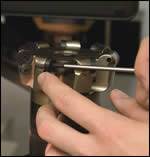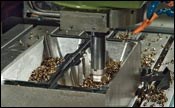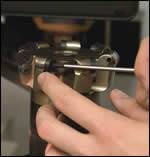Improve Process Economics For Roughing Mold Cavities in Hardened Stock
Mold manufacturer improves cavity hogging and debottlenecks key operation on popular hardened stock with a facemill featuring three flutes with 6-sided inserts.
Want to improve process economics for roughing mold cavities in hardened stock? Take a tip from Minco Tool and Mold Inc., which capitalized on an “exception that proves the rule” in machining tooling economics—and saved handsomely as a result. With 85 employees, the Dayton, OH mold and diemaker operates 24/5 or 24/7, depending on volume.
The operation at issue is rough milling of mold cavities/cores in an increasingly popular mold stock, 15-5 PH stainless steel hardened to Rc40. The alloy owes its popularity to excellent polishability and corrosion resistance at the finishing stage. But back at the roughing stage, unfortunately, it’s a bear. It’s abrasive and gummy, and really heats up during cavity roughing, which often leads to sudden cratering failures at the cutting edge. For that reason, Minco couldn’t risk running the operation unattended.
When Rules of Thumb Don’t Apply
What rule? What exception? A familiar rule of thumb says that on a typical machining job, machining and labor time represent about 75 percent of total part cost, with tooling accounting for only about 3 to 5 percent. “That rule may apply for production parts in softer machinable steels and non ferrous metals,” says Glen Mullins, Minco Procurement Manager. “One key exception, though, is hard metal machining, where the balance shifts significantly. In fact, for cavity roughing this hardened 15 5 PH stock, the tooling that proved optimal represented more than one third of total machining cost.”
Surprisingly, the facemill of choice for this punishing job, an Ingersoll Power-Feed+ mill, wasn’t even the fastest, though it came close—within 10 percent. But its tooling cost proved to be two thirds lower than the nearest competitor, which in dollar terms more than offset the small gap in speed.
Minco’s Presenting Problem
The retooling effort began when Mullins headed up Minco’s effort to clear up this bottleneck operation on such a promising mold cavity/core material. The original tooling was a four-flute indexable face mill, with each insert providing three edges. It had worked fine on a variety of other metals that Minco runs, but not on hardened 15-5 PH. Even when process engineers lowered the feedrate and took a shallower cut, the operation still ran too slow and wrecked too many inserts prematurely—and unpredictably—due to edge cratering.
“We could have lived with the lower removal rate, but not the insert replacement costs,” says Mullins. Contributing to the expense was the fact that cratering on a single edge often rendered the entire insert worthless. “If the failure mode were edge wear, we could simply index the insert because the other edges would still be good,” he explains. “Not so with cratering-type failures.”
Rivals in the Room
To find a best-practice solution, Mullins gathered a cross-section of leading tooling supply companies together in the same room, presented the challenge and invited them to give it their best shots. Invited were compan-ies already supplying Minco, plus several others. “Putting them all in the room at once, I think, helped produce a better answer sooner,” Mullins says.
“We cast a pretty wide net here because we believed that the 15-5 PH material showed great promise over the long term,” Mullins adds. “Optimizing the roughing operation once and for all for that material would be well worth the effort.”
Two-Step Evaluation Process
All were invited to demo their tooling—once. Then Mullins and Ed Draper, CNC Manager, narrowed the field to two finalists, and ran comparative tests of their own design on identical cavity blocks of the actual hardened stock.
The sample blocks measured 6.00 x 12.50 x 19.50 in. with two cavities 4.000 inches deep Test criteria included tool geometry, feed, speed, depth-of-cut, chip load, stepover, spindle load, volume of material removed, cycle time and tooling cost. All tests were run on the same vertical CNC machining center.
Minco’s original cutter was a zero-rake, four-flute design with 3-sided inserts. One of the finalists used five 4-sided inserts, and the Ingersoll Power-Feed+ mill featured just three flutes with 6-sided inserts.
General Lessons from Confidential Tests
Minco regards actual times, machine settings and costs as confidential, but offered some general findings showing how sometimes the exception proves the rule. Both finalists finished the blocks in half the time as the original tool, with the 5-flute cutter completing the cavities about four minutes faster than the Ingersoll Power-Feed+ mill. But because the Ingersoll three-flute Power-Feed+ mill used only three inserts, each with six edges, its tooling cost was lower by nearly 70 percent. Furthermore, in the winning case, tooling cost was 35 percent of total machining cost, more than 10 times higher than the general machining rule of thumb.
Although the three inserts on the Ingersoll Power-Feed+ mill each face a higher chipload than the five on the other, the Ingersoll inserts lasted longer because of two key differences in geometry at the cutting edge: higher positive rake and the helical geometry. The higher rake reduces cutting forces while the helical edge reduces shock and impact as the insert enters the hardened material.
“The harder the workpiece material, the greater the benefit of free cutting geometries and helical edges,” explains Ken Clack, Ingersoll field engineer who assisted with Minco’s retooling. “Positive rake creates a cleaving action at the cutting edge, rather than scraping. With the helical edge, the insert enters the material a little at a time, like scissors shearing paper.”
The freer cutting geometry also reduced residual heat in the mold blocks, the root cause of those catastrophic cratering failures in the original tooling. “That geometry also puts more of the machining heat into the chip, leaving less into the workpiece,” says Clack.
Potential for Unattended Operation
In fact, now that Minco has standardized on the Power-Feed+ mill for this roughing operation, the process has proven secure enough to run unattended. “With edge wear rather than cratering as the edge failure mechanism, we can predict edge life reliably, and schedule indexings accordingly,” says Draper.
Related Content
Fundamentals of Designing the Optimal Cooling System
The right mold components can help improve mold cooling and thereby produce higher-quality parts.
Read MoreThe Benefits of Hand Scraping
Accuracy and flatness are two benefits of hand scraping that help improve machine loop stiffness, workpiece surface finish and component geometry.
Read MoreMaintaining a Wire EDM Machine
To achieve the ultimate capability and level of productivity from your wire EDM on a consistent, repeatable and reliable basis, regular maintenance is a required task.
Read MoreIt Starts With the Part: A Plastic Part Checklist Ensures Good Mold Design
All successful mold build projects start with examining the part to be molded to ensure it is moldable and will meet the customers' production objectives.
Read MoreRead Next
Cutting Tool Trio Trims Time
New cutting tools offer increased tool life, decreased spindle wear and greater cutting speed—resulting in shorter leadtimes.
Read MoreHow to Use Continuing Education to Remain Competitive in Moldmaking
Continued training helps moldmakers make tooling decisions and properly use the latest cutting tool to efficiently machine high-quality molds.
Read MoreHow to Use Strategic Planning Tools, Data to Manage the Human Side of Business
Q&A with Marion Wells, MMT EAB member and founder of Human Asset Management.
Read More



























